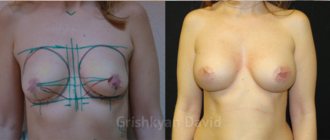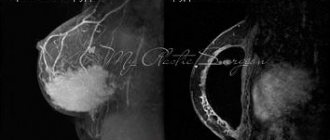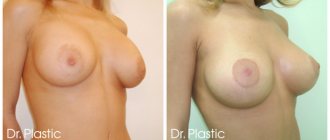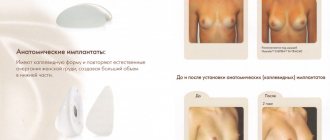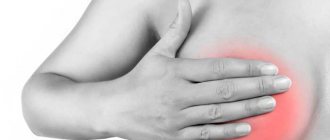Rehabilitation after breast correction involves some restrictions, which are gradually removed during 6 months of recovery, so every woman should know what not to do after mammoplasty. After all, the flawless and desired result of aesthetic surgery is a joint work of the plastic surgeon and the patient. It is extremely important to strictly follow all the doctor’s recommendations and consult with him on basic issues: when, after breast augmentation, can you remove the compression underwear and replace it with a new beautiful bra with underwire? What medications should I take? How to care for your skin and when can you resume sports? Unfortunately, there are no unambiguous and generalized answers to these questions, since the course of rehabilitation is extremely individual. Specialists of the clinic named after. N.I. Pirogov is always in touch and guides her patients from the moment of initial consultation until the successful completion of rehabilitation.
When can you start playing sports after mammoplasty?
The gym is visited no earlier than 2 months after the intervention. Classes begin with light physical activity. Limit training to the upper shoulder girdle. Lifting barbells and dumbbells weighing more than 2 kg is prohibited. The main load is placed on the legs - squats, lunges, abs. Then they do athletics, lifting dumbbells from a lying position.
They return to full-fledged sports activities no earlier than 6 months after the operation.
The Butko Plastic clinic has been successfully performing mammoplasty operations for many years. The intervention is carried out by a reputable surgeon Igor Aleksandrovich Butko, a doctor with twenty years of experience. The doctor explains in detail what can be done in the postoperative period, what exercises are allowed, and talks about the consequences of non-compliance with the regime. Accurate implementation of all recommendations guarantees an excellent result of the intervention.
Stages of return to classes:
- The first 3-4 days - rest and bed rest.
- In the first two weeks - walking at a leisurely pace.
- Up to two months of light physical exercise for the body, with the exception of the shoulder girdle and chest.
- After 2 months of rehabilitation - light physical activity in the gym. Over time, running and athletics exercises are allowed, but only after medical consultation.
What exercises can you do after surgery?
- For the first 2–3 weeks, only walking is allowed. It is prohibited to lift any weights.
- At 4–6 weeks, a woman can slowly raise her arms up. The shoulder girdle is being developed.
- After 2–2.5 months, lifting dumbbells weighing up to 2 kg is allowed.
- 2.5 months after the operation, short distance swimming is allowed.
- After 3 months, you can pump up your abs, do stretching, and raise your arms above your shoulders.
- After 6 months, push-ups and stretching of the chest muscles are performed. Only after medical consultation.
- Tennis, kickboxing or mountaineering are allowed to be practiced one year after the intervention.
Seroma
A seroma is a cavity filled with fluid. The more extensive the breast surgery, the higher the risk of its occurrence. It appears as a lump, the area of which may be painful. If an infection penetrates into the seroma, redness, swelling, severe pain occurs, and body temperature rises.
What to do? Small seromas may not be treated. If the cavity is large enough, the doctor can perform a puncture: insert a needle and remove the fluid. If after repeated punctures the seroma recurs, the question of surgical intervention arises.
Make an appointment with a surgeon-mammologist
Capsular contracture
By sewing implants into a woman’s breast, the surgeon essentially introduces a foreign body into her body, and the reaction to it cannot always be predicted. Sometimes scar tissue grows around the implant, and it appears as if enclosed in a dense bag. In this way, the body tries to distinguish “foreign” from its own tissues.
This condition is called capsular contracture and is one of the most common complications of breast augmentation surgery. Why it happens to some women and not to others - even scientists cannot answer this question.
Scar tissue prevents the implant from moving naturally. The chest becomes deformed and pain may occur.
There are four stages of capsular contracture:
- I - minor changes, when the breast looks normal, the implant is in place, and moves relatively easily.
- II - the breast has a normal shape, but is a little dense to the touch;
- III - the breast is deformed, the implant is displaced, shifted upward or to the other side, a lump is palpable;
- IV - symptoms are the same as in the third stage, but are even more pronounced.
Scar tissue can be seen on breast X-rays.
What to do? Capsular contracture should be treated as early as possible. Over time, the situation only gets worse. Therefore, if you notice the first signs, you should immediately consult a doctor. Sometimes medications help soften the scar tissue around the implant (according to some data, zafirlukast ).
For women who have not been helped by drug treatment, the only option is surgery - breast capsulotomy. During it, the capsule is completely removed from the scar tissue around the implant. In some cases, relapse is possible after surgical treatment.
Does massage help ? Massage is effective only as a preventative measure. Typically, plastic surgeons recommend doing it for several months after surgery. This helps reduce, but not eliminate, risks.
In patients who are professionally involved in sports, the gland as such is either almost absent or very small. Drying affects adipose tissue - fatty tissue decreases in volume, leaving iron behind.
Choosing a method for installing implants
There is no ideal method for breast enlargement. Each method of installing implants has its pros and cons.
When we place implants under the muscle, the shape of the breast changes slightly as the muscle tightens. When we place it under the gland, with tension in the arms, the shape of the breast remains more natural, but the likelihood of contractures and subsequent contouring of the implant is still higher.
If we determine that the thickness of the mammary gland is more than 3 cm, we can place it under the gland. I have been practicing plastic surgery for 23 years. Previously, we mainly installed implants under the gland. Why? Previously, patients had more glandular tissue and we installed implants of 180, 200, 220, 240 ml. 240 ml was already considered a lot. If you remember, our grandmothers, as a rule, did not have the issue of breast enlargement. Unlike modern youth, for some reason they had more glandular tissue.
Nowadays, on average, we install implants of 280, 300, 330 ml. The implants have become larger, the gland has become smaller, and if you install it under the gland, the implant will quickly begin to contour. That is why we are now trying to install the implant as deep as possible in order to avoid contracture as much as possible.
If an athlete gets an implant under the gland, the implant begins to put pressure on this already very thin gland.
Atrophy occurs and the implant is visible to the naked eye. Therefore, the implant is placed under the muscle.
However, even when we place implants under the muscle, atrophy of the gland still occurs over time. Depending on the size of the implant and the patient’s tissues. Let’s say a thin patient has breast size 1, but she wants 3-3.5, that is, a large implant. I always explain that if the implant is large, at the beginning everything will be fine, but in the future, and quite quickly, contouring will occur. The implant rests on the ribs, and in front of it there are softer structures - muscle, gland, skin. The implant puts pressure on the gland from the inside and the gland atrophies, becomes thinner, and therefore the implant begins to contour and be palpated.
Photo from Jodie Marsh's Instagram
Installation under the muscle is still only suitable for girls who simply keep in shape through sports and do not intend to set records.
Because when we place an implant under the muscle, a shell is formed around the implant - a capsule. And if the muscle is strained, this shell with the implant can rupture.
I had a case when, 3 years after the operation, a patient at the airport, removing a heavy suitcase from the conveyor belt, sharply pulled it. The pectoralis major muscle, which is fused to the capsule, became tense, and the capsule ruptured and the implant shell ruptured, since it was also fused to this capsule from the inside.
A breast enlarged with an implant is one of the weak points for the rest of your life. And this chest cannot be injured, so it is necessary to exclude impacts and sudden heavy physical exertion, sudden movements (for example, lifting a barbell). But those of my patients who do yoga, Pilates and similar types of physical activity did not come to me with ruptured implants. As a rule, when an exercise is performed slowly, the pain syndrome turns on and this also controls the movement.
Sports in the postoperative period
After breast augmentation surgery, you need to take care of yourself. How to take care - no one will give a clear recipe, everyone has their own.
The load on the pectoral muscles can be given no earlier than 1.5 months after the operation, and then the load should be very light. Loads such as a barbell - in about 3 months. We need to choose - either we lift the barbell and don’t look at whether the implant will rupture, or we still take care of our chest and take a moderate approach to these types of sports loads.
When you can play sports at full strength is decided individually, since everyone’s physical fitness is different. The patient himself must determine that he is comfortable and that the exercises do not cause excessive stress and discomfort.
Possible side effects during exercise and sports
Surgery is not an exact science. If everything goes well for one patient, complications may arise for another. For example, a seroma forms. In my practice there were 3 similar cases. The cause is usually inflammatory diseases. And one girl had an injury. She was on holiday in Turkey and jumped off a pier hand in hand with her children. When my chest hit the water, I felt a slight crunch. Then I returned home and caught a cold due to the climate change, after which seroma appeared. I had to puncture and remove this liquid.
The implant can turn over due to sports stress, which is important when using an anatomist. But after surgery, I always install drains through which excess fluid comes out. Therefore, the implant is located in a dry cavity, fixes and grows very quickly. And then the likelihood of its displacement is minimized.
A lot can happen after surgery. In the human body it is easier to remove something, and it will generally cope, than to build it up. But, unfortunately, today humanity has not come up with anything better than implants for breast enlargement.
To communicate with patients who have undergone breast augmentation, lifting or reduction, come to our forum in the Mammoplasty
Recommendations for the recovery period
How long it takes for swelling to subside after breast augmentation depends on compliance with medical recommendations in the postoperative period.
- Sleep on your back for 7 days.
- Mandatory use of compression garments.
- Restriction on raising your arms above shoulder level for 14 days - possible displacement of the implants.
- Prohibition on moving heavy objects.
- Visiting baths, saunas, and solariums is not recommended for six months.
- You should not resort to intense sports training for 2-3 months. Scandinavian or race walking, swimming, flex, exercise therapy are shown.
- Refusal to play sports for 2-4 weeks after mammoplasty. It will increase blood pressure, which will negatively affect the healing process.
Minimizing postoperative manifestations, including swelling, depends on the doctor’s compliance with the rules of asepsis and antisepsis, the technology of the operation, and the correct choice of shape, volume and height of the implant.
First week after surgery:
All you need to do is rest. It should be understood that the metabolic rate increases after surgery, so even during complete rest, the extra calories that worry most women will “burn” many times faster. To relieve any possible pain or discomfort after surgery, your doctor may recommend lightly stretching your muscles without resorting to even mild exercise. In general, walking in the fresh air is always beneficial. But even if pain or discomfort occurs, they should be canceled.
↑ When to start worrying
If the thermometer stays at 37-38 for 7-10, maximum 12 days after the operation, there is no particular cause for alarm. But only if there are no other unpleasant symptoms. You should immediately consult a doctor if, in addition to hyperthermia, you have:
- Local redness in the area where endoprostheses are installed, pain when touching the gland.
- A sudden increase in edema, the appearance of compactions in the area of the postoperative wound.
- Discharge of a cloudy fluid mixed with blood or pus at the suture sites, from the nipple.
These manifestations may signal the addition of an infection and the development of an inflammatory process. With fever, local symptoms are usually supplemented by general ones: nausea, headache, loss of strength.
- What are the complications after breast surgery and how to avoid them?
- Why can the chest and back hurt after mammoplasty, how long does it last and when does it go away?
If the mercury has risen beyond 38.5 degrees or the temperature persists for more than 12 days, this is also a reason to urgently contact your surgeon or any other available doctor.
Sergeev Ilya Vyacheslavovich Plastic surgeon, Candidate of Medical Sciences, leading specialist in breast plastic surgery at the DoctorPlastic clinic
One of the obvious signs of a developing inflammatory process in the body is an irregular temperature. In the morning, as a rule, the thermometer shows normal numbers - 36.7-36.9. But in the evening the patient’s condition worsens, swelling increases, accompanied by painful sensations. And the thermometer rises to 38-38.5 degrees. And this is an alarm bell that indicates the need to urgently visit a doctor.




